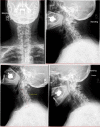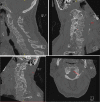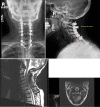C1-T2 decompression and fusion for C2 erosive pannus-a case report
- PMID: 34321454
- PMCID: PMC8319170
- DOI: 10.1038/s41394-021-00429-y
C1-T2 decompression and fusion for C2 erosive pannus-a case report
Conflict of interest statement
The authors declare no competing interests.
Figures






References
Publication types
MeSH terms
LinkOut - more resources
Full Text Sources
Miscellaneous

